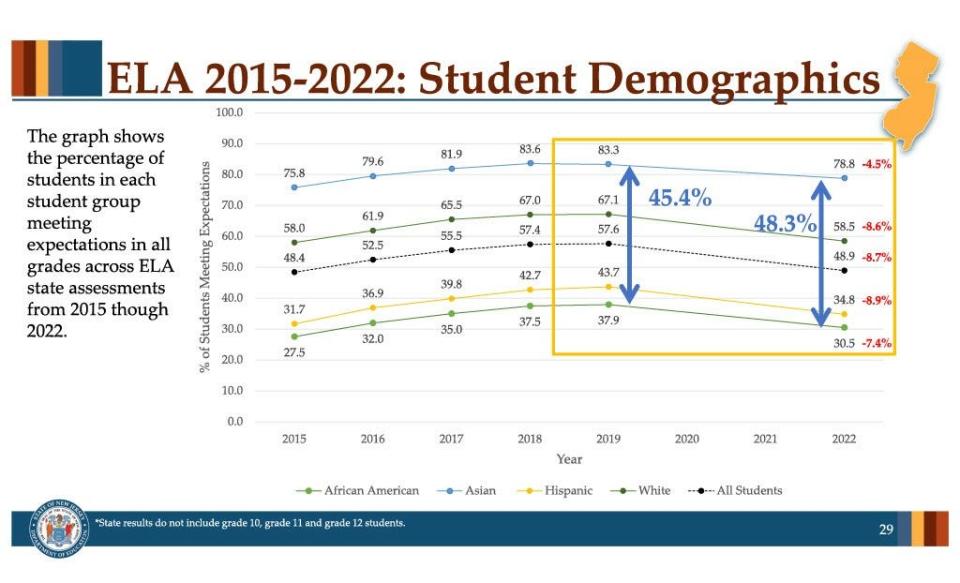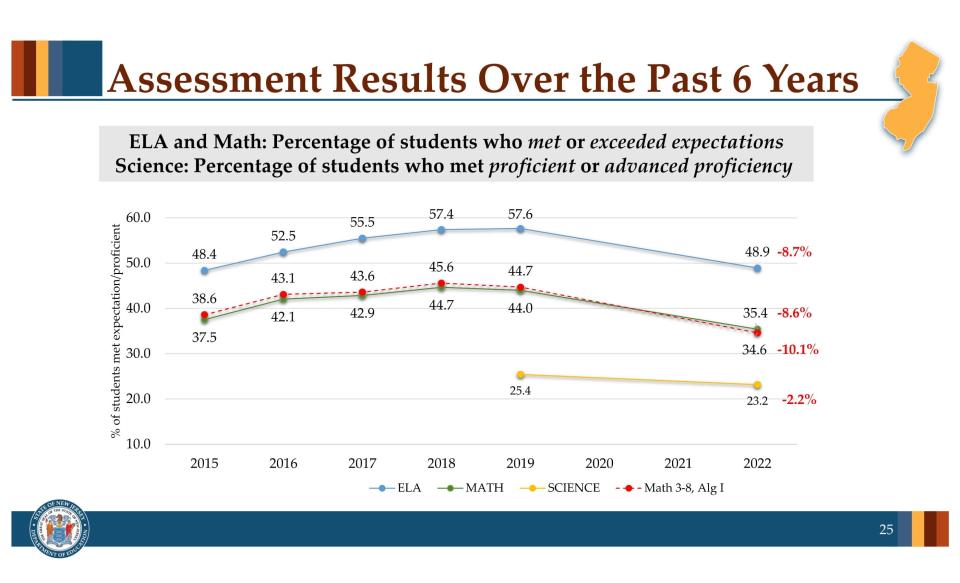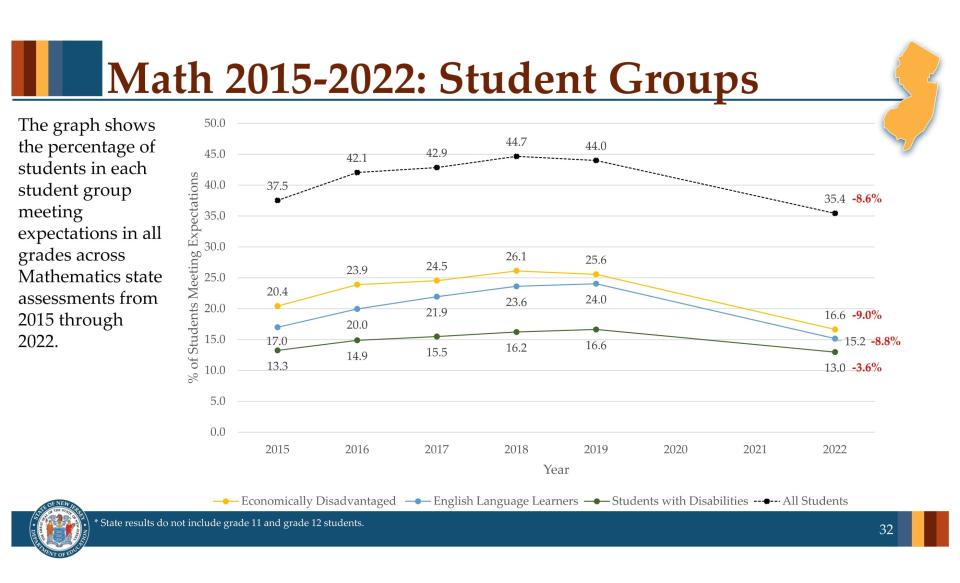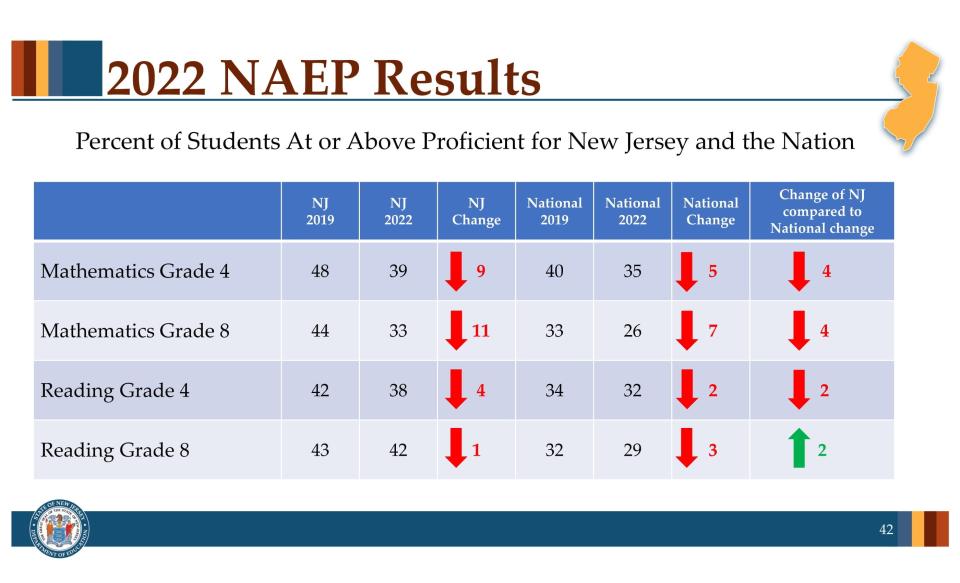NJ responds to a big drop in K-12 test scores with a tutoring 'call to action'
New Jersey students broadly underperformed on the New Jersey Student Learning Assessments administered in the spring, results show.
In the first post-pandemic statewide assessment test, scores fell to the lowest in five years, according to information released by the state Department of Education this week.
But that’s not news, experts are saying. The lower scores in math and English were expected, and they mirror drops in performance and learning across the nation.
The bigger question is how New Jersey will help its K-12 students bounce back, and why the state did not also release key district-by-district data to support the trend information it presented.
Recognizing the urgency of the learning loss evident from the drop in scores, state acting Commissioner of Education Angelica Allen-McMillan issued a “call to action” for 5,000 volunteers to pitch in as “caring adults” to serve as tutors, mentors and coaches for students.

There will also be a $135 million investment in “high-impact tutoring” through a grant from American Rescue Plan funds that will help students recover from the learning loss, the state announced Wednesday. An earlier release from the state on Dec. 1 slated $10 million for tutoring.
Details are to be provided, but interested individuals can apply for the New Jersey Partnership for Student Success on the state website: nj.gov/education/njpss.
The percentage of New Jersey’s students who met or exceeded proficiency levels in English language and math dropped from the highest numbers, recorded in 2019, just before the pandemic, to numbers that mirror a low point in 2015. Students showed an 8.7% drop in language arts and a nearly 10% loss in math in NJSLA testing that aligns with state standards. NJSLA tests were administered in 2022 after a two-year suspension during the pandemic. The drop in science scores was less drastic, down 2.2% from 2019 to 2022.
Grades seven and eight showed the greatest decrease in meeting expectations, with a 10% drop between 2015 and 2022. Drops in performance were most “acute” in math, the state reported.

The state did not release comprehensive data on how each district performed on the NJSLA.
Education watchers’ hopes were up when the state announced last week that it would release statewide assessment data on Wednesday on an already-delayed schedule. That did not happen during a six-hour meeting with the state Board of Education when Allen-McMillan and her team discussed trends from scores on the NJSLA test and NJGPA, the state's high school graduation test.
The tests were conducted in spring. The state also released trends in Dynamic Learning Maps (DLM) and ACCESS for English Language Learners testing.
The state usually releases all testing data in October or November. Even though it delivered this information to schools on time in the summer, New Jersey is now one of only two states that have yet to release urgently needed, post-pandemic comprehensive testing data for the public and researchers to determine which student groups need the most help and in what areas, said Paula White, a former state Education Department official and head of the advocacy group JerseyCAN.
The state said it will release the district data in the coming weeks.

It is critical to know exactly how the state plans to implement its program of volunteers and tutoring, said White and Harry Lee, who heads the New Jersey Public Charter Schools Association. Both said they support tutoring as a solution.
“We know that high-dosage tutoring implemented well can accelerate learning for kids,” Lee said.
State Board of Education member Joseph Ricca asked the acting commissioner to ensure that the tutoring program, which will use COVID relief money, has appropriate fiduciary checks and balances, and that the administrative costs and details of big contracts are “really carefully scrutinized.”
Targeting tutoring and contracts to districts and students that need them most is critical, and outside experts said that although the state informed them about its plans, they can weigh in on where the money goes only after they get the data they need.
The department has "integrity monitors" and "a public dashboard for every school district updated monthly for their spending," Allen-McMillan said. She said she would provide updates to the State Board of Education for the next six months on the progress of the state's response to the drop in scores through its new partnership program.
The scores
The drop in student scores is “stark,” an Education Department official said at Wednesday’s meeting, but it was also the first broad measure of student learning after the pandemic. It also possibly did not reflect small gains in 2021, which showed up in some states that conducted testing that year, he said.
It is more important to recognize the learning loss and support children and their teachers, “regardless of their ZIP code,” without dwelling on forming an “opinion of how we performed during the pandemic,” Ricca said.
“Sometimes when we look at these numbers, we forget that there are human beings being counted. We forget that in those numbers are death, loss of jobs, inability to connect with instruction on a structured basis, closing and opening of classrooms and schools … despite the hard work of teachers across the state,” Ricca said. What’s not addressed in these numbers is systemic trauma and systematic lack of opportunity, he added.
In the 2022 administration of New Jersey’s NJGPA, 39.5% of students showed graduation readiness in English and 49.5% in math (Algebra 1 and Geometry). Advocates criticized the test because it used a higher cut score of 750, despite the state Department of Education’s recommended score of 725.

The exam was changed to a field test after further outcry from education advocates and experts, who said a brand-new, untested exit exam with a higher cut score would hurt high schoolers, especially those from low-income and urban districts, who had already faced the brunt of learning loss and disruptions over two years of closed and hybrid schools. A law passed at the very last minute in July 2022 changed the NJGPA from an exit test to a field test.
In that test, Asian and white students scored higher on average than all students, while African American and Hispanic students demonstrated proficiency below the student average. English language learners and students with disabilities all performed below the student average.
Similarly, the largest drop in scores on the NJSLA across demographic groups was among Hispanic students, at 9%, compared with 4.5% among Asian students. The gap between the highest- and lowest-performing student groups increased compared with previous years. For example, the gap between the percentage of Asian students and Hispanic students who met expectations in all grades, except 10, 11 and 12, increased from 45.4% in 2019 to 48.3% in 2022.
This is an echo of achievement gaps that have existed for years but were made worse by the pandemic, said a former schoolteacher and advocate who did not want to be named.
The pandemic was hard; now let’s go forward, Ricca said.
“We are looking at who is most in need, and where we can leverage this program to the best extent,” Allen-McMillan told the state school board about implementing tutoring. She said schools were being asked to focus on communities where English is not the main language, low-income communities and various demographic groups within school districts.
The state board members made several recommendations to the commissioner, including requests for additional testing data and a suggestion that Headstart providers be included in groups the state will tap for paid tutoring services.
This article originally appeared on NorthJersey.com: NJ responds to a big drop in K-12 test scores with 'call to action'


